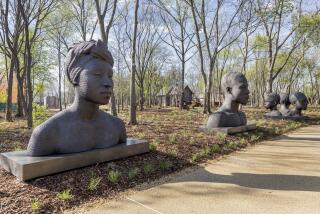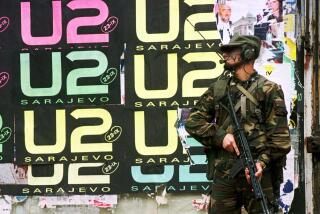A jumble of realities in Bosnia’s Sarajevo
- Share via
SARAJEVO, BOSNIA-HERZEGOVINA — The artists of Sarajevo were always a cheeky bunch. They made the craters left by mortar shells look like flowers and inaugurated an international film festival in the middle of a war.
These days, their canvas is a field beside the city’s history museum, where they recently erected a monument to the suffering that Bosnians endured during the brutal war of the early 1990s:
A 10-foot replica of a tin can of meat.
It is blue and gold and reminds every Sarajevan of the years under siege, being fed by well-meaning, if clueless, aid workers.
“That stuff was so bad that if your cat ate it, his fur would fall off,” Jela Dzino, a 68-year-old retiree, reminisced about the donated Spam-like substance.
Those behind the monument say the point is clear: Art can be used to recount and even lampoon the past.
The past remains a complicated issue in Bosnia-Herzegovina, where the Muslim, Croat and Serb factions who fought, killed and died are living in peace again, but hardly in harmony.
Providing their own testament to the vicissitudes, dozens of museums and art exhibits have sprung up in Sarajevo since the end of the war 12 years ago, all competing to tell a version of history that is often politicized, minimized or distorted. And in the jumble, some Sarajevans worry, the city is losing its famous multiethnic tradition.
Museums dormant
“One of our problems is that we are trying to change history and the past and make it better than it was, especially each for their own ethnic group,” said Jacob Finci, something of an elder statesman in Sarajevo who is in charge of developing a new civil service for Bosnia.
Finci said that as various groups squabbled over how history should be told, including a government made up of Muslims, Serbs and Croats, museums lay dormant for far too many years after the war ended. It took a decade to reopen the venerable Jewish Museum; the National Museum opened, then closed because of money shortages (and eventually reopened).
The graceful 19th century neo-Renaissance palace that houses the National Museum survived its unfortunate location on the combat front line, emerging battered but salvageable. Today, although one temporary exhibition portrays Ottoman-era Bosnian life, the museum’s primary collections are of medieval tombstones, prehistoric fossils and Roman antiquities -- mostly items from before the land was populated with Serbs, Muslims and Croats.
“You cannot see the multiethnic Bosnia in the National Museum,” Finci complained, with only a bit of hyperbole. “The word ‘national’ is complicated in Bosnia. Here you say ‘national,’ and the question is, ‘Which nation?’ ”
Like the city and its past, many monuments and museums are reinventing themselves.
Nowhere is this more true than on the riverfront street corner near downtown Sarajevo where, on June 28, 1914, Gavrilo Princip assassinated Archduke Franz Ferdinand, heir to the Habsburg throne, and his wife, Sophie, setting off World War I.
For several decades after World War II, Princip, a young Serb who died four years after the duke’s assassination, was a national hero in communist Yugoslavia, having struck a blow against Austro-Hungarian imperial tyranny -- or so said the plaque commemorating the spot. A museum there, in Princip’s honor, was required visiting for Yugoslav schoolchildren, his footprints from where he fired the shots were bronzed, and his name was given to streets and bridges.
But when Serbs began shelling Sarajevo in 1992 and killing hundreds of Muslim residents, Princip fell quickly out of favor. The museum was vandalized and closed.
This year, the site and, to an extent, the story were rehabilitated. The new Museum of Sarajevo 1878-1918 opened, containing artifacts salvaged from the earlier museum, but presented in a just-the-facts tone.
“The story changed,” said a bemused Nermin Dzino, 37, a former soldier in the Bosnian army who today works as a driver. “Princip was a terrorist, a hero, a terrorist. . . .”
The biggest difference is that in the current version, being part of the Austro-Hungarian empire (read: Europe) is no longer such a bad thing.
When the city’s mostly Muslim officials inaugurated the museum, they declared, to the horror of their Bosnian Serb counterparts, that Austro-Hungarian occupation was “an exceptionally rich period” that “significantly contributed to the European concept of the development” of Sarajevo.
Sniper’s Alley
Another new entry in the evolving museum-and-art scene is found at the Historical Museum, housed in an early-1960s Modernist building sitting at one end of the boulevard that became known during the war as Sniper’s Alley. During Yugoslavia’s Tito years it celebrated communism; today it honors the siege.
Its exterior steps are still fractured from the Serb mortar fire that pummeled the Bosnian capital. On the second floor, curators have assembled mementos from the years that the city was surrounded and essentially imprisoned by Serb forces.
Relics include the old stove-and-pipe contraptions that Sarajevans jury-rigged for cooking and heating, and samples of humanitarian aid being resold by war profiteers, such as an 80-deutsche mark can of oil. Newspapers from the day and scores of photographs recount much of the carnage, showing bombed-out apartment buildings and bloodied schoolrooms, little desks splintered and book bags scattered.
“Every document speaks for itself,” said Amar Karapus, one of the museum’s guides. “Everyone wants to represent history in their own way, and so here we are fighting every form of revisionism.”
Outside the museum, in a field that was a killing zone in the early ‘90s, stands the 10-foot canned-meat monument. It came into being as part of an internationally funded competition launched by artist Dunja Blazevic and Sarajevo’s Center for Contemporary Art.
In the competition, called De/construction of Monument, artists were asked to respond to postwar efforts to “erase memory and rewrite history,” Blazevic said.
Across the former Yugoslav federation, she noted, monuments (not to mention bridges, buildings and places of worship) were destroyed not in fighting but in an attempt to wipe out a previous system or a part of history or an ethnic presence.
The new crop of artists, she said, was inspired to produce new monuments and place them in public space to reach ordinary citizens.
It took more than a year to obtain the permits to erect the canned meat, Blazevic said; authorities were afraid of the statue’s provocative message and, especially, of offending the international community, she said.
Another work to come from the project is a statue that pays homage to Bruce Lee. It’s a tongue-in-cheek salute meant to show that a Chinese American martial arts expert is more of a hero than the “heroes” produced by the war -- the “war criminals,” as Blazevic, 60, put it.
Blazevic, who lived most of her life in Croatia and Serbia but made a deliberate move to Sarajevo after the war, said she hopes the explosion in artworks, monuments and museums will stimulate debate and frank examination of what happened, and is still happening, in this country.
But a lot of Bosnians are not there yet.
Josh Kirkwood, 27, a tourist from Australia, was visiting some of the sites with a Bosnian Muslim guide. They stopped at one of the oddest museum-monuments, the once-top-secret tunnel that was used to smuggle food, people and weapons in and out of besieged Sarajevo during the war.
Kirkwood, an economist, learned that some things are still too sensitive when he asked his guide what he thought of the Serbs. The guide refused to comment.
“And that,” Kirkwood said, “was the end of the questions.”
More to Read
Sign up for Essential California
The most important California stories and recommendations in your inbox every morning.
You may occasionally receive promotional content from the Los Angeles Times.











